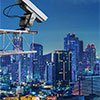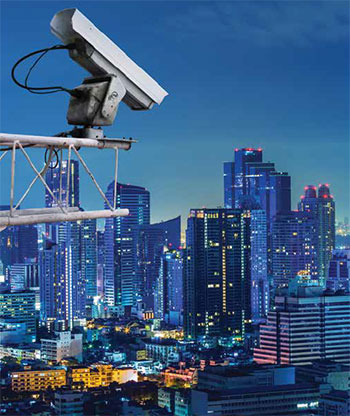
In Clear View
Megapixel cameras can actually help you see what is in the image
- By Ralph C. Jensen
- Mar 01, 2014
 High definition and megapixel cameras play an important role in
video surveillance applications. They can provide images that are
more useful, with a higher quality of detail and have wider coverage
than standard-resolution cameras.
High definition and megapixel cameras play an important role in
video surveillance applications. They can provide images that are
more useful, with a higher quality of detail and have wider coverage
than standard-resolution cameras.
In his book, Intelligent Network Video, author Fredrik Nilsson
wrote, “Megapixel resolution is one area in which network cameras excel over
analog cameras. A megapixel, fixed, network camera can be used in one of two
ways. It can enable viewers to see greater details in an image, or it can be used
to cover a larger part of the scene, if the image scale is kept the same as a nonmegapixel
camera.”
“Megapixel resolution first hit the market in fixed and fixed dome IP cameras,
and even today the technology can be found in all form factors, including PTZ
domes and even covert IP cameras,” said Nilsson, who is also general manager
Americas for Axis Communications.
Megapixel cameras come with a high-value proposition. For starters, the aim
of a megapixel camera is to obtain a high-resolution overview of any given scene.
Consider a shopping mall, for example. The primary goal of a camera installation
may be to watch people and view their movements, or maybe the goal is to see if
the parking lot is empty or nearly at capacity.
Megapixel can also be used in demanding situations where it’s needed to identify
persons or objects in a scene.
“With a megapixel camera, an end user is going to see a good image,” said Scott
Shafer, executive vice president at Arecont Vision. “For instance, before the megapixel
camera came along, a sports arena would be a difficult place to cover. Now,
it is the right camera to use in this type of venue, where it quite possibly will help
reduce the number of cameras needed and in use.”
Megapixel cameras are used in a number of key industry verticals, helping to
address some video surveillance challenges. Nilsson reminds dealers and integrators
what some prime opportunities may be for this type of solution.
City surveillance. Megapixel network cameras provide high-resolution, video
streams from locations where it is necessary to clearly identify people and objects,
or to get a larger overview while viewing live or recorded video.
Government buildings. Megapixel cameras provide the exceptional image detail
necessary to facilitate the identification of people and to record evidence of any
suspicious behavior.
Retail. A drastic reduction in theft and shrinkage can result from effective video
surveillance. Megapixel network cameras can either provide an overview of a large
part of a store—without any blind spots—or offer highly-detailed images of the
sales counter area.
School and campuses. The use of megapixel resolution cameras in hallways
makes it easier to identify students.
But Nilsson often reminds security professionals that the term “megapixel”
only refers to one aspect of image quality: the number of pixels in an image. It is
a term better suited for the still photography world instead of the video world, he
says, because megapixel format as such does not guarantee frame rate, aspect ratio
or color fidelity.
This is where, Nilsson says, HDTV-compliant video has made an impact on the
surveillance world, “By following the SMPTE standard for HDTV, user’s receive
a wider 19:9 field-of-view to see more of the scene, are guaranteed smoother, full
frame rate video, can trust that the video’s color fidelity matches the real world,
and that they’re getting 720p or 1080p resolution.
“This is why we watch football games at home in HDTC, not megapixel,” he said.
Speaking of football, Shafer said that many NFL stadiums are making the
change to megapixel cameras, and while individual teams compete on the field,
security staffs from various stadiums talk about what works best to keep the venue
safe and secure for all. When it comes to security, there is no competitive feeling,
but rather a desire to provide safety.
“The reason we are sold on megapixel to begin with is because it is less costly to
deploy than standard IP cameras,” Shafer said. “Areas that were difficult to cover
in past-times can now be covered with high-quality, high-resolution images. Using
H.264, the image is compressed much better, and it makes using the camera much
more efficient.”
Megapixel cameras are often put in place to allow an infrastructure to catch up
with the latest technology.
Brian Carle, chief technical officer of Salient Systems, said that megapixel cameras
are typically considered a best-of-breed, security solution and are a technical
driver in the industry.
“They are a strong differentiator between using megapixel and analog; that’s obvious
to everyone,” Carle said. “There is a very strong argument for megapixel, if
not for one reason but to reduce the camera count and provide a much better image.
“More consumers want megapixel cameras, even though they require more storage
capability and bandwidth. From our point of view, as a VMS software provider,
the video management solution has to be designed to handle higher-resolution video,
meaning there must be more processing power to handle the throughput.
“What megapixel cameras offer is higher-quality video at the scene.”
At the scene, for instance, could
mean retail security where point-ofsale
monitoring is necessary to clearly
see every item a customer is buying or
situations where it would be necessary
to identify a face. End users can even
get high-detailed images by installing a
network camera with a telescopic lens
or a zoom lens to get closer to the area
of interest.
“A network camera that offers
megapixel resolution uses a megapixel
sensor to deliver an image that contains
1 million or more pixels,” Nilsson
said. “The more pixels a sensor has, the
greater the potential it has for capturing
finer details and for producing a
higher-quality image.
“In the video surveillance industry,
some best practices have emerged regarding
the number of pixels required
for certain applications. For an overview
image, it generally requires 80 pixels
from ear-to-ear to identify a person.”
While megapixel technology has
changed the industry, Nilsson says
there are some drawbacks.
“As in any surveillance installation,
there is no way one camera fits all solutions,”
Nilsson said. “Integrators need
to understand when megapixel is the
answer for an application, and when
it isn’t.”
Nilsson said that lower light sensitivity,
expensive lenses, sacrificing
frame rate and increased storage can
all be potential tradeoffs when using
megapixel. Yet, he said, that by sticking
to industry standards and following
along with Moore’s Law, megapixel and
HDTV cameras will only get better.
Integrators agree that megapixel
cameras are the future. Commercial
businesses are moving quickly toward
the megapixel revolution, primarily
because of the resolution of the image.
The detail of the image upon playback
is so much better that the end user
should never have any worries about
what they are looking at.
“The megapixel camera offers better
coverage and search functionality,”
said Ray Gilley, president and CEO of
ISI Security. “We also see the cost of
megapixel cameras inching down. As
an integrator, we sell more megapixel
cameras than anything else.”
Gilley noted that 90 percent of their
orders during 2013 were for megapixel
cameras.
“People who deploy megapixel cameras
find them to be more scalable and
easier to use when growing their security
system,” said Gilley. “What we find is
that the buyer actually becomes its own
IT department.”
Until the next great innovation in
camera technology, security-industry
professionals seem to agree that megapixel
cameras are not to be lightly regarded,
but in fact are the popular
choice for protecting employees, assets
and facilities.
This article originally appeared in the March 2014 issue of Security Today.